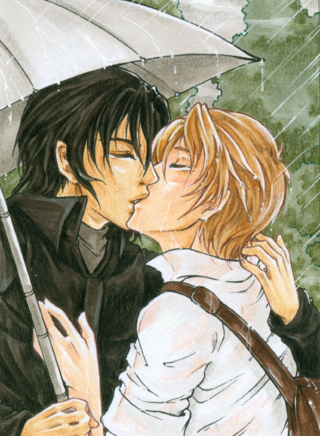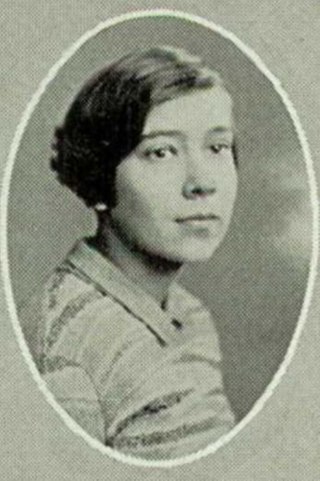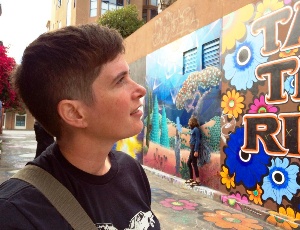Related Research Articles

Yaoi, also known as boys' love and its abbreviation BL, is a genre of fictional media originating in Japan that features homoerotic relationships between male characters. It is typically created by women for women and is thus distinct from bara, a genre of homoerotic media marketed to gay men, though yaoi does also attract a male audience and can be produced by male creators. Yaoi spans a wide range of media, including manga, anime, drama CDs, novels, video games, television series, films, and fan works. While "yaoi" is commonly used in the west as an umbrella term for Japanese-influenced media with male-male relationships, "boys' love" and "BL" are the generic terms for this kind of media in Japan and much of Asia.

Biphobia is aversion toward bisexuality or people who are identified or perceived as being bisexual. Similarly to homophobia, it refers to hatred and prejudice specifically against those identified or perceived as being in the bisexual community. It can take the form of denial that bisexuality is a genuine sexual orientation, or of negative stereotypes about people who are bisexual. Other forms of biphobia include bisexual erasure.

LGBT themes in speculative fiction include lesbian, gay, bisexual, or transgender (LGBT) themes in science fiction, fantasy, horror fiction and related genres.[a] Such elements may include an LGBT character as the protagonist or a major character, or explorations of sexuality or gender that deviate from the heteronormative.

Lambda Literary Awards, also known as the "Lammys", are awarded yearly by Lambda Literary to recognize the crucial role LGBTQ writers play in shaping the world. The Lammys celebrate the very best in LGBTQ literature. The awards were instituted in 1989.

Lesbian pulp fiction is a genre of lesbian literature that refers to any mid-20th century paperback novel or pulp magazine with overtly lesbian themes and content. Lesbian pulp fiction was published in the 1950s and 1960s by many of the same paperback publishing houses as other genres of fiction, including westerns, romances, and detective fiction. Because very little other literature was available for and about lesbians at this time, quite often these books were the only reference the public had for modeling what lesbians were. English professor Stephanie Foote commented on the importance of lesbian pulp novels to the lesbian identity prior to the rise of organized feminism: "Pulps have been understood as signs of a secret history of readers, and they have been valued because they have been read. The more they are read, the more they are valued, and the more they are read, the closer the relationship between the very act of circulation and reading and the construction of a lesbian community becomes…. Characters use the reading of novels as a way to understand that they are not alone." Joan Nestle refers to lesbian pulp fiction as “survival literature.” Lesbian pulp fiction provided representation for lesbian identities, brought a surge of awareness to lesbians, and created space for lesbian organizing leading up to Stonewall.

Gay literature is a collective term for literature produced by or for the gay community which involves characters, plot lines, and/or themes portraying male homosexual behavior.
Cleis Press is an American independent publisher of books in the areas of sexuality, erotica, feminism, gay and lesbian studies, gender studies, fiction, and human rights. The press was founded in 1980 in Minneapolis, Minnesota. It later moved to San Francisco and was based out of Berkeley until its purchase by Start Media in 2014. It was founded by Frédérique Delacoste, Felice Newman and Mary Winfrey Trautmann who collectively financed wrote and published the press's first book Fight Back: Feminist Resistance to Male Violence in 1981. In 1987, they published Sex Work: Writings by Women in the Sex Industry by Delacoste with Priscilla Alexander.

LGBT themes in horror fiction refers to sexuality in horror fiction that can often focus on LGBTQ+ characters and themes within various forms of media. It may deal with characters who are coded as or who are openly LGBTQ+, or it may deal with themes or plots that are specific to gender and sexual minorities.
Gay teen fiction is a subgenre that overlaps with LGBTQ+ literature and young adult literature. This article covers books about gay and bisexual teenage characters who are male.

Bisexual erasure, also called bisexual invisibility, is the tendency to ignore, remove, falsify, or re-explain evidence of bisexuality in history, academia, the news media, and other primary sources.

Valerie Taylor was an American author of books published in the lesbian pulp fiction genre, as well as poetry and novels after the "golden age" of lesbian pulp fiction. She also published as Nacella Young, Francine Davenport, and Velma Tate. Her publishers included Naiad Press, Banned Books, Universal, Gold Medal Books, Womanpress, Ace and Midwood-Tower.

Gay pulp fiction, or gay pulps, refers to printed works, primarily fiction, that include references to male homosexuality, specifically male gay sex, and that are cheaply produced, typically in paperback books made of wood pulp paper; lesbian pulp fiction is similar work about women. Michael Bronski, the editor of an anthology of gay pulp writing, notes in his introduction, "Gay pulp is not an exact term, and it is used somewhat loosely to refer to a variety of books that had very different origins and markets". People often use the term to refer to the "classic" gay pulps that were produced before about 1970, but it may also be used to refer to the gay erotica or pornography in paperback book or digest magazine form produced since that date.

Lesbian literature is a subgenre of literature addressing lesbian themes. It includes poetry, plays, fiction addressing lesbian characters, and non-fiction about lesbian-interest topics. A similar term is sapphic literature, encompassing works that feature love between women that are not necessarily lesbian.

Dena Hankins is an American novelist and short story author, best known for queer and transgender erotic romance. Her short stories have been published in several erotica anthologies, including Best Women's Erotica of the Year, Volume 8 edited by Rachel Kramer Bussel. Her non-fiction articles about sailing, electric motors for sailboats, and DIY boat repair have been published by the trusted British magazine Practical Boat Owner and she edited several editions of the boater's cruising guides published by The Waterway Guide.

The following outline offers an overview and guide to LGBT topics.
Bisexual literature is a subgenre of LGBT literature that includes literary works and authors that address the topic of bisexuality or biromanticism. This includes characters, plot lines, and/or themes portraying bisexual behavior in both men and women.
Black lesbian literature is a subgenre of lesbian literature and African American literature that focuses on the experiences of black women who identify as lesbians. The genre features poetry and fiction about black lesbian characters as well as non-fiction essays which address issues faced by black lesbians. Prominent figures within the genre include Ann Allen Shockley, Audre Lorde, Cheryl Clarke, and Barbara Smith.
Rebekah Weatherspoon is an American author and romance novelist. Her books often feature heroines who are Black, plus-size, disabled, and/or LGBTQ. She founded the website WOC in Romance. Weatherspoon received a 2017 Lambda Literary Award for her novel Soul to Keep and was an honoree at the inaugural Ripped Bodice Awards for Excellence in Romance Fiction for Xeni.
Maria Pallotta-Chiarolli is an Australian academic, author and activist specializing in the study of gender, sexuality and intersectionality. Pallotta-Chiarolli is an Honorary Fellow at Deakin University, and a member of its Gender and Sexuality Studies Network and LGBTIQ+ Network, researching in gender diversity, cultural diversity, family diversity and sexual diversity. She is also the author of Australia's first AIDS biography.
Adriana Herrera is an author of romantic fiction and erotica. She was born and raised in the Dominican Republic and now resides in New York City.
References
- 1 2 3 "What women want: Gay male romance novels" article. Retrieved February 11, 2019.
- ↑ Bussel |, Rachel Kramer. "A Wider Embrace: Romance Novels 2020". PublishersWeekly.com. Retrieved September 7, 2023.
- ↑ "The Price of Temptation by M.J. Pearson | Smart Bitches, Trashy Books". smartbitchestrashybooks.com. Retrieved February 3, 2021.
- ↑ "Best M/M Romance Published in 2009 (210 books)". www.goodreads.com. Retrieved February 3, 2021.
- ↑ "Best M/M Romance Published in 2008 (108 books)". www.goodreads.com. Retrieved February 3, 2021.
- ↑ LeSage, S. (2009, 05). Editorially speaking: Of springtime mornings, androphilia, and M/M romance. The Liberty Press, 15, 4–5.
- ↑ Lundgren, A. (2009, Mar). False Colors: An M/M Romance. Colorado Springs Independent.
- ↑ "M/M Romance" Rolling Stone. 10/14/2010, Issue 1115, p90-90.
- ↑ Cintra Wilson, "W4M4M? Out" Los Angeles Vol. 20, Iss. 2, (Sep 1, 2010): 98–103.
- ↑ Thomas, Devon. 2011. "Bodice rippers without the bodice: ten male-on-male romances for a core collection." Library Journal. Feb 15Volume 136. Issue 3. Page 40.
- 1 2 3 4 "Finding Love In All the Right Places: Romance 2015" Publishers Weekly; New York Vol. 262, Iss. 23, (June 8, 2015).
- ↑ "About Us". Riptide Publishing. Retrieved February 3, 2021.
- ↑ "Three digital M/M and LGBT romance publishers sound off – Crane Hana Books". www.cranehanabooks.com. Retrieved February 3, 2021.
- ↑ Beecroft, Alex. "Why Do Women Write M/M Romance?" The Macaronis: Historical Fiction Out of the Closet. http://historicromance.wordpress.com/2008/08/15/why-do-women-write-mm-romance/
- ↑ Foster, Guy Mark (October 2, 2015). "What To Do If Your Inner Tomboy Is a Homo: Straight Women, Bisexuality, and Pleasure in M/M Gay Romance Fictions". Journal of Bisexuality. 15 (4): 509–531. doi:10.1080/15299716.2015.1092910. ISSN 1529-9716. S2CID 36922639.
- ↑ Shramko, Lizzy. "Can M/M Romance Challenge the Definition of LGBT Lit?." Lambda Literary 18 (2010).
- ↑ Foster, Guy Mark (October 2, 2015). "What To Do If Your Inner Tomboy Is a Homo: Straight Women, Bisexuality, and Pleasure in M/M Gay Romance Fictions". Journal of Bisexuality. 15 (4): 509–531. doi:10.1080/15299716.2015.1092910. ISSN 1529-9716.
- ↑ Hermes, Joke. "Sexuality in Lesbian Romance Fiction." Feminist Review 42.1 (1992): 49–66.
- ↑ Juhasz, Suzanne. "Lesbian romance fiction and the plotting of desire: Narrative theory, lesbian identity, and reading practice." Tulsa Studies in Women's Literature 17.1 (1998): 65–82.
- ↑ Stimpson, Catharine R. "Zero degree deviancy: The lesbian novel in English." Critical Inquiry 8.2 (1981): 363–379.
- ↑ Ehnenn, Jill. "Desperately Seeking Susan Among the Trash: Reinscription, Subversion and Visibility in the Lesbian Romance Novel." Atlantis: Critical Studies in Gender, Culture & Social Justice 23.1 (1998).
- ↑ Rose, Suzanna, Debra Zand, and M. Cini. "Lesbian courtship scripts." Rothblum & KA Brehony (Eds.), Boston marriages: Romantic but asexual relationships among contemporary lesbians (1993): 70–85.